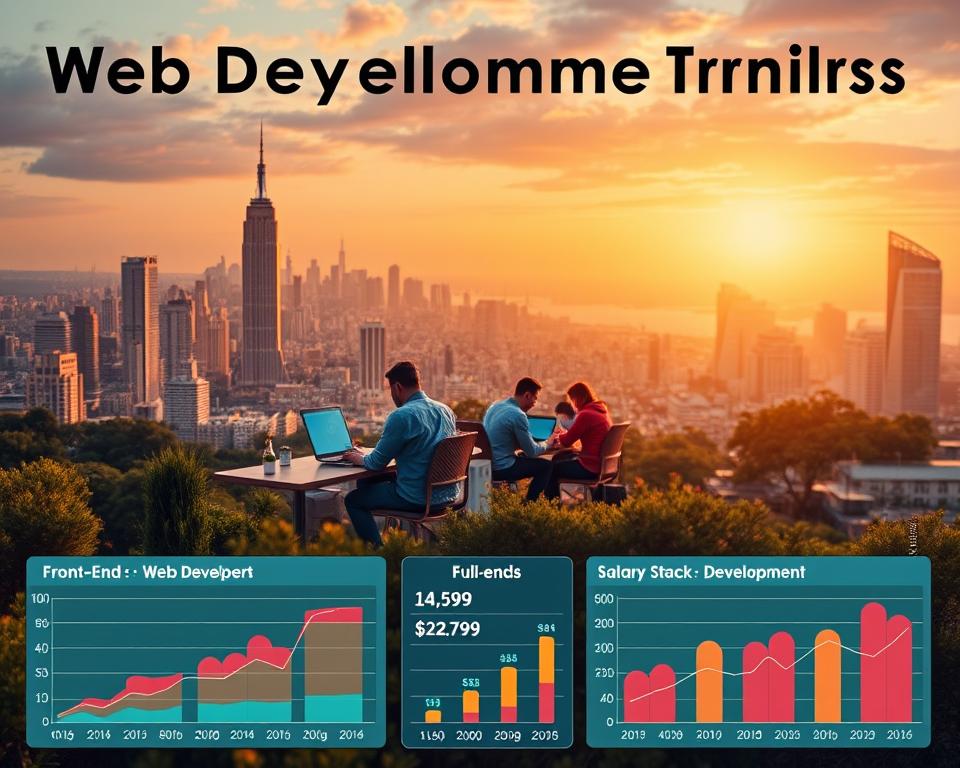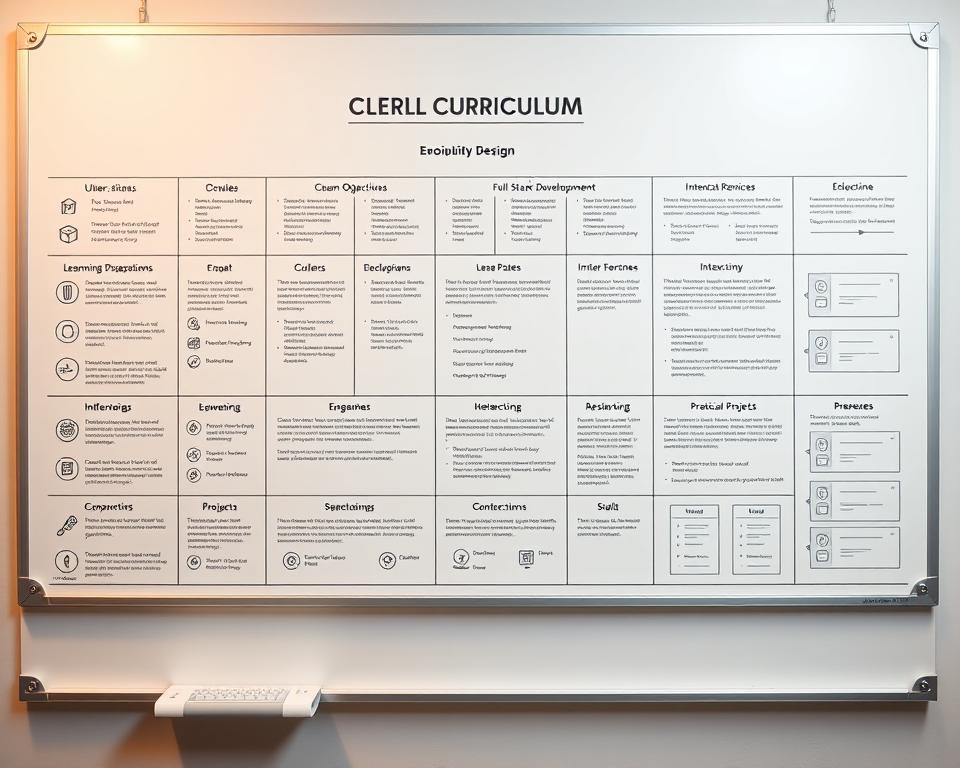
Full Stack vs. Front-End Development: Which Bootcamp Is Right for You?
Surprising new data reveals coding bootcamps now produce job-ready professionals at record speed. But choosing between specialized front-end training and comprehensive full-stack programs remains a critical decision. Like building a house, back-end development forms the structural foundation through databases and server logic, while front-end work creates user-facing interfaces that visitors interact with daily.
Accelerated learning programs take different approaches to skill-building. Front-end-focused courses prioritize visual design, responsive layouts, and JavaScript frameworks. Full-stack alternatives combine these client-side skills with server management and database architecture. Your choice directly impacts the types of roles you’ll qualify for after graduation.
Bootcamp structure matters more than many realize. Programs emphasizing portfolio development and real-world projects help students stand out in competitive tech markets. Shorter front-end courses (12-16 weeks) appeal to visual learners, while full-stack programs (20-28 weeks) demand broader technical endurance.
Key Takeaways
- Bootcamp graduates achieve comparable hiring rates to degree holders in web roles
- Front-end training focuses on user interface design and client-side programming
- Full-stack programs teach both front-end and back-end development skills
- Program length varies significantly between specialization types
- Project-based learning increases job market competitiveness
- Curriculum choices affect initial career opportunities and growth paths
Understanding Web Development Roles
Every website you visit is a collaboration between unseen engineers and visual designers. Three primary specialties drive modern digital experiences: client-side creators, server architects, and hybrid developers who bridge both worlds.
What is Client-Side Development?
Client-side specialists craft what users see and touch. They transform design concepts into functional interfaces using HTML, CSS, and JavaScript. These developers ensure websites adapt to different screens and load quickly.
Key responsibilities include:
- Building responsive layouts
- Implementing interactive features
- Optimizing visual performance
Exploring Server-Side and Hybrid Roles
Server engineers work behind digital curtains, managing databases and security protocols. They ensure data flows securely between users and servers using languages like Python or Ruby.
Hybrid developers combine both skill sets. They troubleshoot issues across entire systems and often lead technical teams. This versatility makes them valuable in startups and smaller organizations.
| Role | Focus Area | Key Tools |
|---|---|---|
| Client-Side | User Interface | React, Angular |
| Server-Side | Data Management | MySQL, Node.js |
| Hybrid | Full System | MERN Stack |
Students should consider their preferred working style when choosing paths. Those who enjoy visual results might prefer client-side work, while problem-solvers often thrive in server-side programming. Hybrid roles demand broader experience but offer greater project ownership.
Industry Insights and Bootcamp Benefits

Tech hiring managers now prioritize specialized skills over general programming knowledge. A 2023 LinkedIn report shows front-end specialists fill roles 22% faster than generalists. This demand reflects companies’ need for experts who master specific parts of website creation.
The Role of Specialization in Today’s Tech Job Market
Focused training in either client-side or full-stack development leads to distinct career paths. Front-end graduates often secure jobs building interactive websites, with average salaries reaching $85,000. Full-stack developers earn higher starting pay ($105,000) but require broader technical endurance.
Key industry trends include:
- Front-end roles growing 18% annually through 2026
- 85% of companies seek candidates with framework expertise
- Specialized bootcamp graduates report 30% higher job satisfaction
| Role | Average Salary | High-Demand Skills |
|---|---|---|
| Front-End | $82k – $98k | React, Accessibility Design |
| Full-Stack | $95k – $120k | Node.js, Database Security |
Bootcamps condense years of learning into months by teaching job-ready languages like JavaScript. This time efficiency helps learners transition careers while meeting current website development needs. Employers increasingly value graduates who can immediately contribute to live projects.
Full Stack vs. Front-End Development: Which Bootcamp Is Right for You?
Educational programs shape career trajectories through targeted skill-building. Bootcamps specializing in client-side technologies prioritize immediate interface creation, while hybrid courses prepare developers for complex system architecture.

Comparing Educational Pathways and Curriculum Focus
Client-side programs dive deep into visual design principles. Students master HTML structure, CSS styling, and JavaScript interactivity within 12 weeks. These courses emphasize portfolio-ready projects that showcase user experience optimization.
Comprehensive programs add server management and database integration. Learners tackle Python frameworks and SQL queries alongside interface design. This dual focus mirrors computer science fundamentals applied to real-world development cycles.
| Program Type | Core Technologies | Project Scope |
|---|---|---|
| Client-Side | React, Vue.js | Single-page apps |
| Hybrid | Node.js, MongoDB | E-commerce platforms |
Employers value specialized graduates for focused roles. A 2023 Indeed survey shows 67% of companies hire client-side developers for immediate design tasks. Hybrid developers often lead teams handling back-end development challenges.
Course structure impacts career flexibility. Focused learners enter the job market faster but may need additional training for leadership roles. Those choosing comprehensive programs gain broader system understanding from day one.
Essential Technical Skills and Tools for Developers
Modern web development relies on mastering specific tools that bring digital experiences to life. Whether crafting interfaces or managing data systems, developers need precise technical abilities to succeed in today’s market.

Core Front-End Technologies: HTML, CSS, and JavaScript
Every visual element users see begins with three foundational languages. HTML structures content, CSS styles layouts, and JavaScript adds interactivity. Front-end developers combine these tools to create responsive designs that adapt to phones, tablets, and desktops.
Industry surveys show 92% of hiring managers prioritize framework expertise like React or Vue.js. Bootcamps focus on practical applications, teaching students to debug code and use version control systems like Git. These skills enable graduates to contribute immediately to live projects.
Back-End Tools and Hybrid Development Languages
Behind every smooth user experience lies robust server infrastructure. Back-end developers use languages like Python and Node.js to manage databases and APIs. PHP remains vital for content-heavy platforms, while SQL handles complex data queries.
Full-stack developers merge both worlds, building complete systems from interface to server. Leading programs teach database security and RESTful API design alongside core languages. This hybrid approach prepares learners for roles requiring end-to-end system understanding.
Project-based curricula in tech education help students master real-world workflows. Graduates leave with portfolios demonstrating their ability to solve practical challenges, a key factor in landing competitive positions.
Market Trends and Career Outlook in Web Development
The tech industry added 178,000 new web development jobs in 2023 alone. Demand for coding expertise keeps rising as businesses expand their digital presence. Front-end roles now grow 16% faster than average tech positions, while full-stack opportunities increase 12% annually.

Job Market Insights and Salary Projections
Recent Bureau of Labor Statistics data shows web developers earn median wages of $85,580. Specialized skills significantly impact earning potential:
| Role | Entry-Level Salary | 5-Year Growth |
|---|---|---|
| Front-End | $72k – $85k | +18% |
| Full-Stack | $88k – $105k | +14% |
Remote work options now account for 43% of web development positions. Employers increasingly value candidates who combine technical science knowledge with collaborative learning abilities. Coding bootcamps address this need through project-based curricula mirroring real workplace challenges.
Industry leaders emphasize specialization. “Companies seek developers who master specific frameworks rather than generalists,” notes GitHub’s 2024 tech report. Bootcamp graduates often outcompete degree holders in landing niche roles, particularly in emerging fields like AI-driven websites.
Career longevity depends on continuous skills updates. Professionals who complete specialized learning programs every 2-3 years see 35% faster promotions. Choosing the right bootcamp creates a foundation for adapting to market shifts while building high-value expertise.
Making an Informed Bootcamp Decision
Choosing the right coding bootcamp requires matching program intensity with career goals. Most courses run 8-16 weeks, with full-time students completing projects 40% faster than part-time peers. This condensed format demands focused learning but delivers job-ready skills quickly.

Analyzing Bootcamp Structure and Learning Outcomes
Quality programs balance theory with hands-on practice. Look for curricula that spend 60%+ time on real-world coding exercises. Key markers of effective design include:
- Portfolio projects mirroring actual workplace tasks
- Daily code reviews with industry professionals
- Final weeks dedicated to collaborative team simulations
Graduates from programs emphasizing these elements secure junior developer positions 35% faster than others. Top bootcamps report 85% placement rates within 3 months post-graduation.
Evaluating Industry Demand and Future Opportunities
Align training with emerging tech needs. Companies currently seek developers skilled in:
| Specialization | High-Demand Skills | Entry-Level Roles |
|---|---|---|
| Interface Design | React, Accessibility | UI Developer |
| System Architecture | Node.js, APIs | Solutions Engineer |
Programs offering specialization tracks help students target specific positions. “Graduates who complete focused JavaScript training often receive multiple offers,” notes a 2024 Codecademy report. Review alumni outcomes to identify bootcamps with proven success in your target field.
Consider program length carefully. Shorter 8-week courses work for career enhancers, while 16-week programs better suit career changers needing comprehensive training. Always verify job placement stats and employer partnerships before committing.
How Can Preparing for Coding Bootcamp Interviews Help Me Choose Between Full Stack and Front-End Development?
Preparing for coding interviews can clarify your interests in development. By tackling questions for both full stack and front-end roles, you’ll discover which aligns better with your skills and passions. This process not only builds confidence but also helps you make a more informed career choice.
Conclusion
Your educational path shapes your technical career trajectory. Specialized programs build focused knowledge in interface design or system architecture, while comprehensive courses develop hybrid problem-solving abilities. Both approaches deliver strong hiring outcomes, with 83% of graduates securing roles within six months according to 2024 Course Report data.
Successful learners match their natural strengths to program demands. Visual thinkers thrive in client-side curricula emphasizing design principles, while systems-oriented people excel in courses teaching database management. This alignment between learning style and technical training boosts skill retention by 41%.
Modern tech education offers viable alternatives to traditional college degrees. Accelerated programs condense essential knowledge into hands-on projects mirroring workplace challenges. Prioritize courses with industry partnerships and proven job placement records when evaluating options.
As you weigh programs, consider how each prepares people for evolving industry needs. Look for curricula updated quarterly to reflect new tools and frameworks. Remember: the best investment combines practical coding knowledge with career support services tailored to your goals.
Whether transitioning from college studies or entering tech anew, your bootcamp choice should balance immediate employability with long-term growth potential. Focused learners who master in-demand skills position themselves for success in our increasingly digital world.